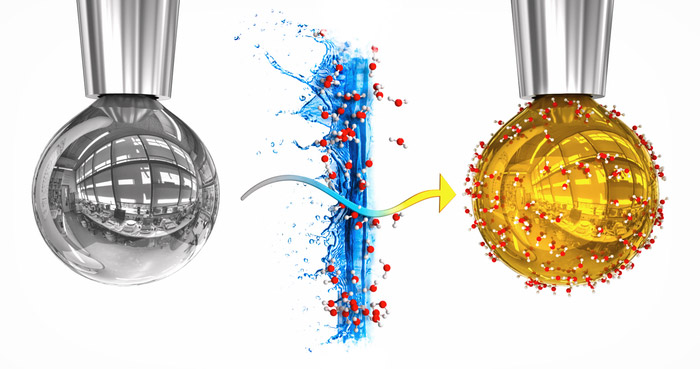
Turning base metals like lead into gold is an age-old dream of alchemists. A group of researchers is taking it a step further. They have found a way to turn water into a metallic, gold-colored material. What’s more, like copper, it is capable of conducting electricity.
The research was undertaken by scientists from the Czech Academy of Sciences, University of Oxford, University of Southern California and the Fritz Haber Institut, among others. The study ‘Spectroscopic evidence for a gold-coloured metallic water solution‘ was published in the academic journal Nature.
Large planets
It has been widely believed in science for some time that this process takes place in the cores of large planets such as Neptune and Uranus where extremely high pressures cause water molecules to be pressed together so hard that the so-called electron shells (imaginary orbits around an atomic nucleus) overlap each other.
Up until now, it was inconceivable that humans would be able to create these types of pressure levels on Earth. But researchers led by the Czech Pavel Jungwirth have developed another method for altering the structure of water.
Explosions
The method expands on earlier research by Jungwirth that focused on the behavior of alkali metals such as lithium and sodium. They did this in a mixture of water and liquid ammonia, which also has metallic properties. Electrons are released from the alkali metal, these then need to be dissolved. Except that the researchers had to overcome one fundamental problem. Namely, as soon as alkali metals come into contact with water, they immediately explode.
YouTube
“Throwing sodium into water is one of the most popular experiments in school and often seen on YouTube videos. As is commonly known, if you throw a chunk of sodium into water, you don’t get metallic water but an instant and sizeable explosion,” says Jungwirth. “To avoid this, we reversed the process. Instead of adding alkali metal to water, we added the water to the metal.”

This was accomplished in a pressurized chamber where a small amount of water vapor was brought into contact with a drop of a sodium-potassium alloy.
Electron Microscope
The water vapor began to condense on the surface of the sodium-potassium droplet. The electrons that were released from the alkali metal dissolved in the water layer faster than the chemical reaction that would normally lead to an explosion.
Jungwirth: “The result was a gold-colored metallic solution” (see photo above). The preliminary tests were conducted in a small laboratory in Prague. Later, they were repeated in Berlin using an electron microscope and a particle accelerator.
Practical jokers
Jungwirth performed the tests together with an old friend of his, British chemist and YouTuber Philip Mason (see video). In 2015, they also carried out a test together with sodium that they exploded in water on a university balcony, to the annoyance of the smokers there.
That pissed everybody off, because that was where people went to smoke.
It just goes to show that great inventions are sometimes based on experiments by practical jokers. The metallic substance only lasted for a few seconds though. So in that respect, there is still plenty of work to be done by Jungwirth and his friends

